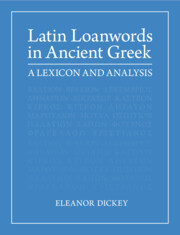Book contents
- Frontmatter
- Dedication
- Contents
- List of figures
- Acknowledgements
- 1 Introduction
- 2 The parameters of this study
- 3 Lexicon
- 4 How were Latin words integrated into Greek? Spelling and inflection
- 5 How were Latin loanwords accented in Greek?
- 6 Which Latin suffixes were borrowed into Greek?
- 7 Why were some Latin words not integrated?
- 8 When were loanwords used?
- 9 Where were loanwords used?
- 10 Which words were borrowed?
- 11 Overall conclusions and remaining questions
- 12 Appendices
- Abbreviations
- References
- Index locorum
- Index of Latin words
4 - How were Latin words integrated into Greek? Spelling and inflection
Published online by Cambridge University Press: 25 May 2023
- Frontmatter
- Dedication
- Contents
- List of figures
- Acknowledgements
- 1 Introduction
- 2 The parameters of this study
- 3 Lexicon
- 4 How were Latin words integrated into Greek? Spelling and inflection
- 5 How were Latin loanwords accented in Greek?
- 6 Which Latin suffixes were borrowed into Greek?
- 7 Why were some Latin words not integrated?
- 8 When were loanwords used?
- 9 Where were loanwords used?
- 10 Which words were borrowed?
- 11 Overall conclusions and remaining questions
- 12 Appendices
- Abbreviations
- References
- Index locorum
- Index of Latin words
Summary
Latin loanwords (and codeswitches) were normally written in the Greek alphabet and took Greek endings. Their spellings started out as approximate transcriptions of the Latin pronunciation (not transliterations of the Latin spelling), but over time the Greek spellings could either remain fixed as the Latin pronunciation changed or be updated to reflect such changes. Most loanwords joined a Greek declensional class that closely resembled their Latin declension, but some changed declension or gender when borrowed. Some borrowings (including all verbs) acquired Greek suffixes as part of the borrowing process. Some loanwords were created by univerbating Latin phrases, making Latin-Latin compounds, or making Greek-Latin compounds with the Latin element taken directly from Latin. Derivatives could also be formed from previously-borrowed loanwords using any of the usual Greek derivation and compoundingprocesses.
Keywords
- Type
- Chapter
- Information
- Latin Loanwords in Ancient GreekA Lexicon and Analysis, pp. 503 - 532Publisher: Cambridge University PressPrint publication year: 2023

